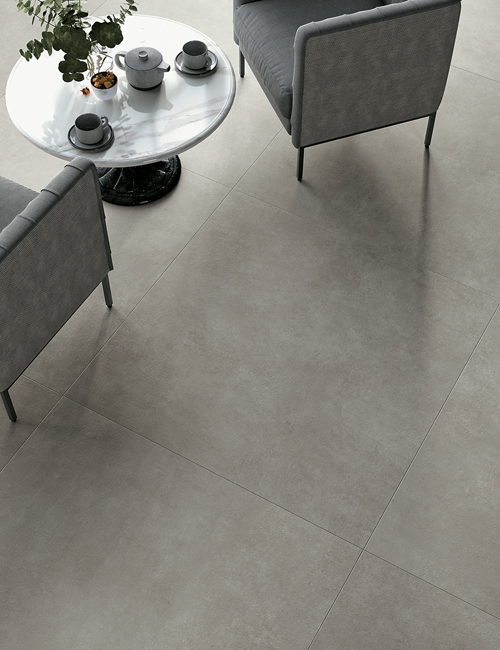Joe Simpson, international correspondent for Discovering Stone, attended a three-day masterclass on porcelain panel fabrication techniques by Roberto Colonetti from Perth-based European Ceramics.
From being one of Western Australia’s largest importers of ceramic tiles, European Ceramics has expanded to include bathroom and kitchen fabrication on an industrial scale, including shower trays, vanities, worktops, island units, and much more.
As a result, the company is now at the forefront of porcelain design and installation, and is an acknowledged expert not just in Western Australia but world-wide.
Roberto’s hands-on porcelain training course covered cutting and detailing to produce invisible mitre joints, detailed step-by-step fabrication of the perfect base structure for basins, worktops, shower trays, sinks, and other items. And, for the purpose of this article, it also looked at the selection of the ideal type of adhesives and grouts for this kind of complex, hand-made, fabrication.
Failure-free performance and high-end aesthetics must go hand in hand form these type of projects.
The session, attended by fabricators mainly from the natural stone sector, along with material suppliers such as Porcelanosa, Neolith, and Dry Treat, really drilled down on this topic. Roberto has extensive experience of using XXL format slabs from Florim, Atlas Concorde, Mirage, and many of the other leading European porcelain slab manufacturers.
He uses adhesives and grouts from major brands like Kerakoll and Mapei, but made no secret that, for him, CerCol provides the optimum range of construction chemicals for bespoke kitchen and bathroom installations, whether manufactured from porcelain or conglomerate alternatives such as Quartzform or Cosentino.
CerCol has created a dedicated product range for this market. It is designed to allow fabricators to maximise the benefits of porcelain slabs such as UV- and chemical-resistance, colour fastness, heat-resistance, and tensile strength. The seamless installation also allows the major advantage of porcelain stoneware – its ability to imitate, through use of modern decorating technology, the characteristic surface textures of materials like marble or corten steel – to be used to maximum advantage.
Ceramic furniture is made by cutting porcelain slabs of different thicknesses to shape, and then bonding them to a preformed framework, generally made of structural composite panels. Roberto prefers Wedi, but also uses other foam-based backerboards for these base structures.
These panels usually contain a core of light polymeric material and are covered on both sides by a thin layer of resin with high mechanical properties, reinforced by fiberglass mesh. To ensure maximum stability and waterproofing, Roberto recommends that these bearing framework panels are glued using CerCol’s F.50 Policol Eco using a notched trowel.
But perhaps the most critical procedure is when the cut porcelain stoneware slabs are glued to these reinforced composite panels using CerCol’s F.49 Poxyrapid, which is applied with a 3mm triangular-shaped trowel to ensure 100% coverage.
The external edges are grouted with F.40 Cerpoxy Art after protecting the edges with masking tape to ensure there is not colour bleed through. After 24 hours, if required, these edges can be sanded down for a perfect finish.
Roberto also demonstrated how this epoxy grout can be easily removed with a hot air gun and craft knife should any imperfections, such as an air bubble, need correcting. This grout removal process is incredibly fast and clean, and simply cannot be achieved with cementitious grouts.
It is even possible – years after the initial application – to remove and replace all the original grout in this manner, either to refresh the appearance or to spice up the installation by adding a contrasting grout.
The other main take-away from Roberto’s masterclass is the vital importance of the accuracy and detail of the slab cutting prior to assembly. He went through the correct sequencing of cuts to relieve the inherent manufacturing stresses in the XXL porcelain slabs, an area little understood by most installers/fabricators, but the key advice concerned the machining of the mitre itself.
Most of the stone fabricators professed to an excessive concentration on achieving precise butt-jointed 90-degree mitres. This may look great initially but is a potential area of failure should any movement occur in the worktop or island, as any failure will take place in the weakest area: the thin edge of the mitre itself.
Roberto advises cutting a precise mitre and then machining the edge again to remove 1mm of material to create a “bird’s beak” detail. The resultant 2mm gap is then filled with colour-matched CerCol F.40 Cerpoxy Art to create a virtually invisible grouted edge that will absorb such slight movements, preventing damage to the slab. It is a neat, simple, but highly important detail that could prevent many failures and site recalls.
F.40 Cerpoxy Art is a two-component epoxy adhesive/sealant suitable for grout joints up to 10mm wide. It comprises a thick paste and a liquid additive. It is supplied in 10kg buckets (9.0 + 1.0) or 5kg buckets (4.5 + 0.5). The grout contains tiny aggregates allowing an equivalent finish to that of the surface of the ceramic slab to be obtained. After the grout is applied, the surface should be finished off immediately using water, white felt and a cellulose sponge to obtain a smooth and homogeneous result.

